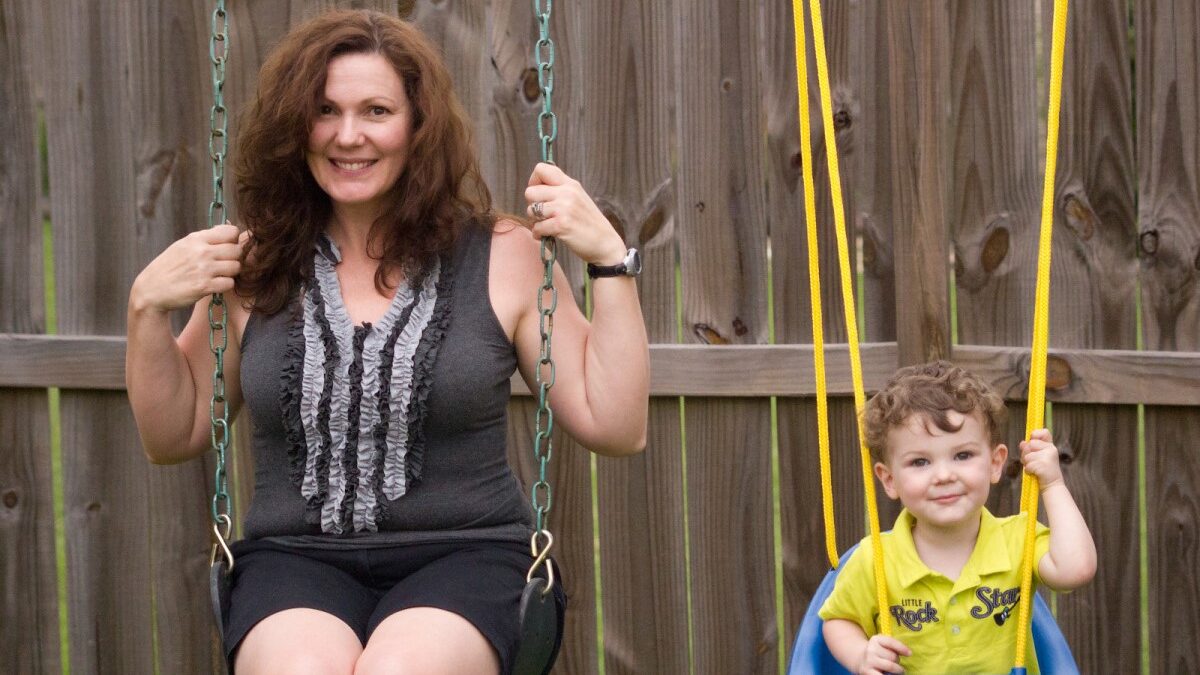
When my son was about 18 months old, he stopped eating. I was convinced something was wrong because the only things he opened his mouth for willingly were liquid Zantac (blech) and pureed prunes (double blech)!
Because of his cystic fibrosis, his doctor had prescribed him a high-calorie formula which, by tricking, tickling, or “forcing” I succeeded in getting him to suck down from a bottle. But he was still steadily losing weight, causing the doctor to broach the possible need for a feeding tube. First, though, she referred him to an occupational therapist for a swallow test.
The test results confirmed my fear—there was a problem. Me! The official diagnosis, I believe, was parental mismanagement. I was putting too much pressure on my son to eat.
Now, in my defense, I was terrified that he was going to die because from his first cystic fibrosis appointment at 14 days old, the entire medical staff stressed the correlation between weight and, as they put it, “outcome.” Despite their antiseptically framed phrase, I knew what they meant: the less he weighed, the less likely he was to survive.
So food became my focus. The less he ate, the more frightened I became, and the more frightened I became, the more pressure I put on him to eat, and the more pressure I put on him to eat, the less he ate. Thankfully, the occupational therapist suggested I read “Child of Mine: Feeding with Love and Good Sense,” by Ellyn Satter.
Two days later, thanks to Amazon Prime and a sleepless night of worry, I had finished the book and recognized the above-mentioned cycle. I immediately changed course, left eating up to him, soldiered through three days of barely any formula consumption, and now—seven years later—have a happy eater.
What does this have to do with parenting “normal” kids? Everything. Satter’s book isn’t about children with medical conditions. Rather, it provides an entirely different perspective to food and feeding. Satter’s approach is evidence-based, meaning scientific studies back it up, and more importantly it makes mealtimes easy and enjoyable!
But while Satter has authored three best-selling books and has been featured in many print and online publications, including Real Simple magazine, The New York Times Magazine, FoodNetwork.com, and Jezebel.com, many people have still not heard of her common-sense approach to feeding. If you are one of those unfamiliar with Satter’s feeding model, but want to start 2017 off on the right fork, here’s what you need to know.
1. Know Your Responsibilities, and Your Children’s
Satter, a registered dietitian, nutritionist, and family therapist, developed the feeding dynamics model, which follows the Division of Responsibility, or DOR, approach to food. DOR stresses that parents have a job and children have a job, and when these boundaries are respected children become competent eaters and parents enjoy peaceful mealtimes.
Here’s how the division of responsibility breaks down for toddlers and adolescents: A parent’s job is to decide the “what, when, and where of eating,” and a child’s job is to decide the “whether and how much to eat.” Thus, parents might decide that breakfast is at 7 a.m., in the kitchen, and consists of scrambled eggs, buttered wheat toast, whole milk, and a banana. A toddler might decide to eat half of a banana and lick the butter off the toast.
“Wait,” you say. “He needs the calcium and protein from the milk. I’m the parent. It’s my job to make sure he eats a well-balanced diet. And besides he asked for scrambled eggs and I went out of my way to make them for him this morning.”
No. And no. It is not his job to decide what to eat, and it is most assuredly not your job to short-order cook for him. It is also not your job to decide whether he will eat or how much he will eat. Your job is to provide the opportunity and the environment for him to learn to eat the foods your family eats. His job is to behave well at meal time (“at least as far as he is able”), and to eat as much as his body needs.
“That’s nuts,” you say. That’s what I thought too when a dietitian suggested the approach to me, without giving it a name. When she asked, “What do you think would happen if you didn’t force Bobby to eat?” I boasted, “He wouldn’t,” as if his survival to that point had been due to my cajoling at meal time. It took reading Satter’s book, learning that scientific studies support the approach, and recognizing myself in the many anecdotes that filled the pages, to accept DOR.
What if you have taken a different approach to food up until now? Maybe you were a clean-plate dictator (like the nuns at my grammar school, who were not smart enough to check in the “empty” crushed milk cartoons when they inspected our trays). Or maybe you were a short-order cook like my mom. How do you transition to DOR?
I asked Satter her thoughts. Before answering, Satter backed me up, inquiring: “Why would the parents want to change their approach to eating? Is something not working?” To me there were two obvious answers that I suggested: first, mealtimes were a constant battle and parents were exhausted. Or second, like me, the parents were at their wits’ end and had tried everything else.
“That’s true,” she agreed, “but you can’t forget the compliant child. Compliant children won’t battle, but they will act unhappy.” Something to consider if you have a complaint child: Does your child act unhappy while you persist in your request that he finish his vegetables? If so, DOR is for you too.
In making the change, Satter suggests that if your child is a preschooler or older, “Tell her there is a change coming, tell her what the change is going to be, and tell her why.” For instance, as Satter explains in her book “Secrets of Feeding a Healthy Family,” you could say, “You know, I have been trying to get you to eat your vegetables. It seems like it hasn’t worked. You don’t like it, and I don’t like fighting with you about it. So, from now on, here is what I am going to do. I am going to put the food on the table, and I am going to leave it up to you to decide what and how much to eat from what’s on the table. What do you think of that?”
2. Plan Family Snacks and Meals
“Interesting,” you think. “Maybe this approach is better. And I am sick of all the mealtime nagging. But I remembered another reason Satter’s approach won’t work. If he only eats half of a banana, he’ll be starving and just beg me for something else to eat in an hour.”
Maybe, but remember, you are in charge of the when and he’ll have another opportunity to eat soon, because under DOR you plan three meals and two snacks a day. With a snack in a couple of hours, he’ll survive (and you will too) until the next opportunity to eat rolls around. If the complaining starts, then just remind him calmly that snack time is in an hour. If he continues, handle it however you handle complaining in general.
Also, consider that your son just might not be hungry for more than a few banana bites. As Katja Rowell M.D., a childhood feeding specialist and author of her second book on the DOR philosophy, “Helping Your Child With Extreme Picky Eating,” explained to me: “Parents need to learn to trust their child’s appetite. Most parents don’t trust their child’s appetite, trying to get them to eat more or different foods. Some days they will eat more, others less. Some children eat more than others. Some children are smaller than others. Almost all children are born with the ability to self-regulate with food. Support those skills by feeding them well.”
But everyone is busy, your son has soccer after school, and your husband leaves for work before breakfast. I asked Ellyn how to handle snacks and meals with everyone’s busy schedule. “Every family is different,” she replied, “but meals need to be with one or both parents.”
She added, “But let’s take a step back and define a meal. A meal means that we all sit down together, look at each other, and share the same food. That could take place on the bleachers of a soccer stadium, at a restaurant, or at home.” Satter also noted that for some parents, they don’t have a “meal” unless the food is “healthy” and home-cooked. “But that’s wrong. It’s the ritual of the family that is the critical ingredient in a meal, not the food.”
3. Be Realistic About Nutrition and Time Demands
Satter’s excellent reminder leads to my third recommendation: Be realistic! Do not set unattainable standards. Your meals do not need to consist of home-cooked masterpieces. There is nothing wrong with take-out, prepared meals, frozen vegetables, or canned fruit. If you need to read it in black-and-white, read Satter’s books where she explains these points in detail. Also know that Satter’s approach has been judged a best practice by many agencies and organizations, including Women Infants and Children, the U.S. Department of Agriculture, and the American Academy of Pediatrics.
I asked Satter her thoughts. She explained that “people tend to be rigid in defining good and bad foods and are often disrespectful of food that is not ‘healthy.’” But, as she explained, “all food is healthy because all food contributes to what your body needs.” She added that “to condemn certain foods as unhealthy is nutritionally naïve. All food makes a contribution to eating and enjoying.”
Rowell agreed, telling me: “Eating disorder professionals also stress that calling foods ‘bad’ or ‘good’ gives too much power to food. It might be ‘fast’ food, “prepared,’ ‘pre-packaged,’ or ‘homemade’ and ‘from scratch.’” According to a Time magazine survey, Dr. Rowell added, “30 percent of millennials feel judged based on what their kids eat.” Her advice:
Let it go. Cut yourself some slack if it’s not organic and home-made all the time. Make eating together the priority, and try to eat at regular times. Sometimes when I’m sick of cooking, if I acknowledge that and use prepared foods, or take-out for a few days, without guilt, I can get back into cooking faster and without resentment. Stressful times may mean more eating out for a while, and that can be okay too. Be kind to yourself and getting back into cooking will be easier.
4. Enjoy Your Family Mealtime
Finally, sit back and enjoy your family meal time together! After all, your job is now done: You’ve decided the what, when, and where your family will eat and can relax and partake in whatever you, Bob Evans, or Mrs. Smith whipped up. Your time with family will be so much more enjoyable if you follow Satter’s DOR approach.
As one young man who worked with Satter shared after his family changed to her feeding approach: “My parenting life is so much easier and more enjoyable now. At meal time, I now focus only on my kids from the neck-up. I no longer watch and worry about what is or isn’t on their plates because I can trust them to eat what and how much they need.”
You too can trust your kids—a lesson I learned the hard way.
Disclosure: I worked grátis with Satter to co-author “Eating Management as a Part of Medical Nutrition Therapy for Children with Cystic Fibrosis,” a Position Statement for the non-profit Ellyn Satter Institute.









